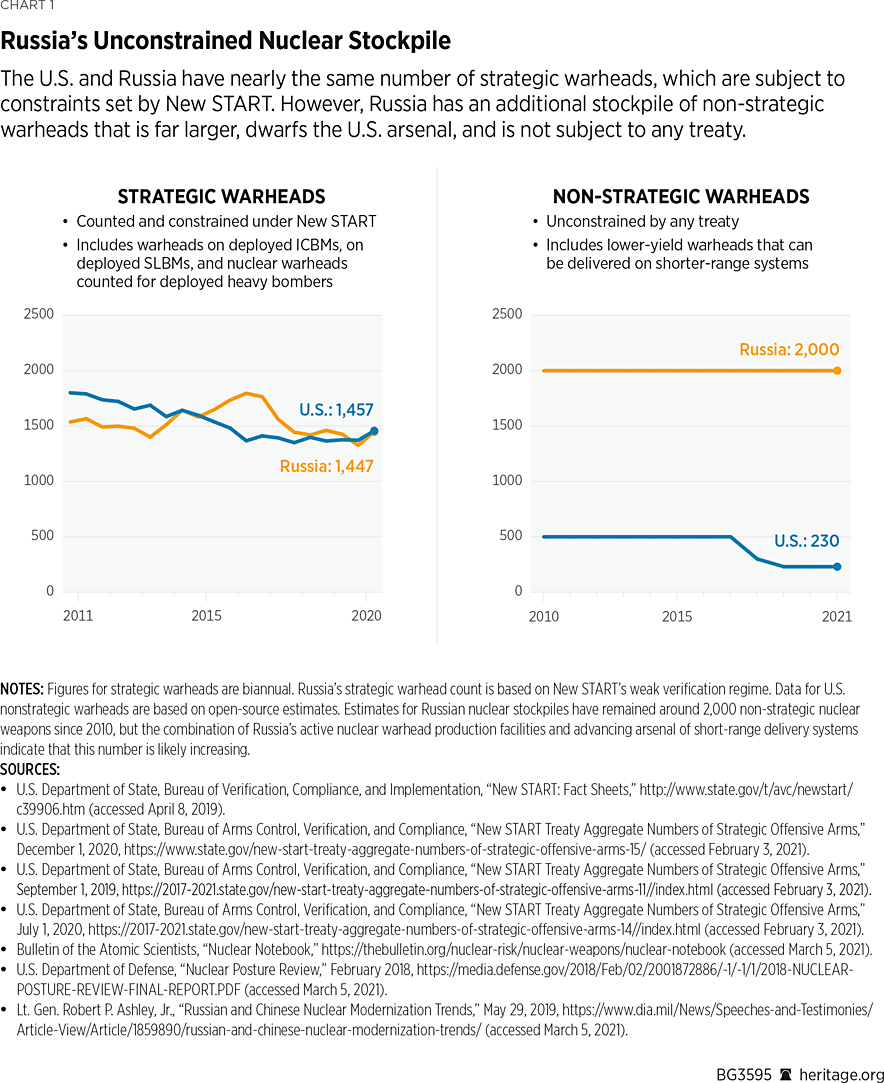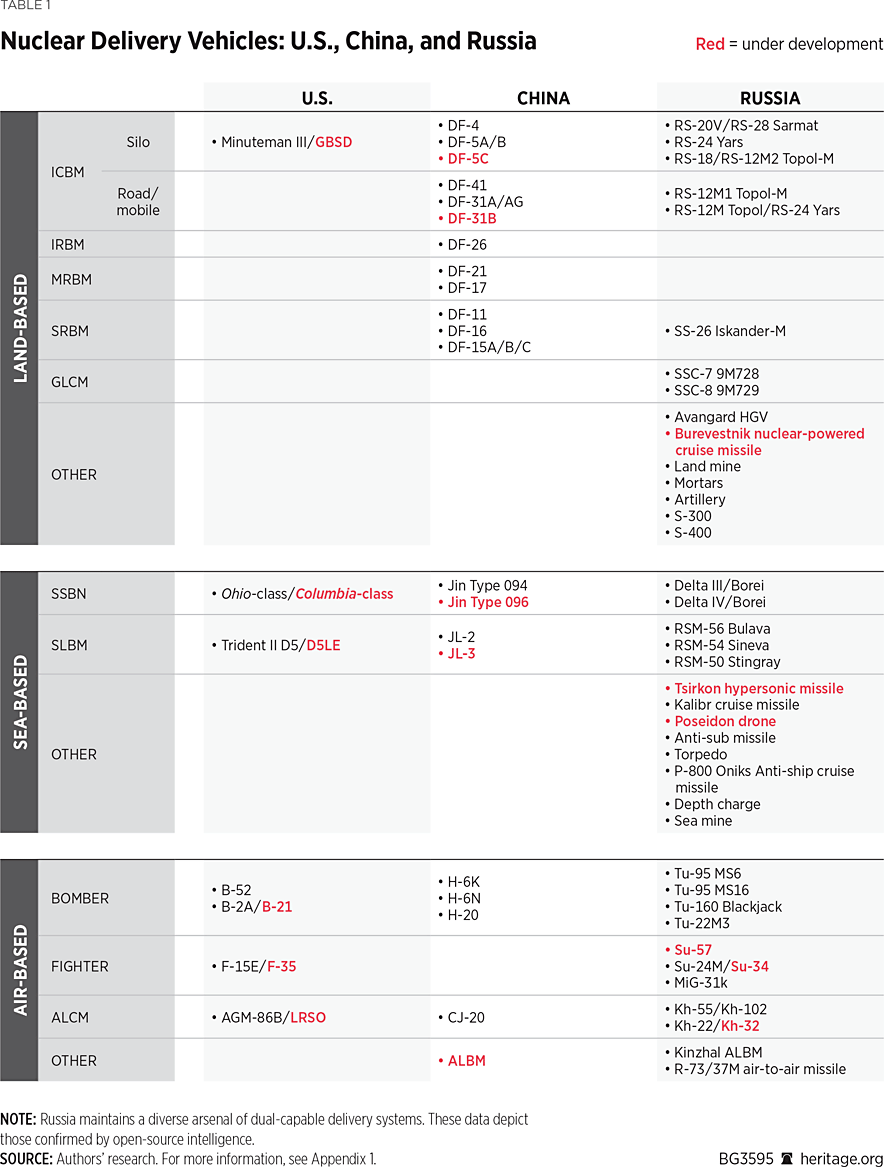The Biden Administration recently agreed to an unconditional five-year extension of the New Strategic Arms Reduction Treaty (New START) with the Russian Federation before it was scheduled to expire on February 5, 2021. New START restricts the number of strategic nuclear delivery systems and warheads each country can deploy, but the treaty contains significant flaws. Instead of continuing the Trump Administration’s efforts to seek improvements to the treaty, the United States received nothing in return for its agreement to extend. In fact, just days later, perhaps feeling empowered to dictate terms, Russian Deputy Foreign Minister Sergei Ryabkov stated that any future treaty must include U.S. missile defense.REF
A New START extension does not equate to nuclear stability, and the United States should not expect it to moderate Russia’s aggressive behavior. Russia and China will continue to advance their nuclear forces as part of their strategies for implementing their respective revisionist national agendas. The United States must not become lulled into a false sense of security offered by another five years of New START; instead, the Biden Administration, with Congress, must remain committed to modernizing U.S. nuclear forces in order to ensure the credibility of the U.S. nuclear deterrent and assurance of allies, while engaging in muscular diplomacy with adversaries.
New START Offers a False Sense of Security
President Joe Biden has agreed to extend New START for five years in an effort to “keep the American people safe from nuclear threats,”REF but New START contains major flaws and an extension does not mean that the United States and Russia have achieved nuclear stability. Even as the United States has unilaterally reduced its nuclear forces since the Cold War, Russia continues to invest heavily in its nuclear forces and uses them to coerce and threaten its neighbors. New START has not moderated these trends—nor should the U.S. expect it to do so.
While the U.S. intelligence community assesses Russian compliance with New START limits on deployed warheads, weak New START verification standards and counting rules undercut the credibility of this assessment.
New START caps the total number of warheads allowed on deployed strategic delivery systems, but it does not limit each type of deployed missile, nor does it limit a missile’s throw-weight, which determines the number of re-entry vehicles that can fit on each missile.REF If, for example, Russia deploys new warheads that are smaller than those that Russia has deployed in the past—with which U.S. inspectors are familiar—Russia can deploy more of them per missile, reaching total deployed warheads above the New START limit with no credible risk of being caught.REF
New START authorizes 18 on-site inspections of nuclear forces per year, which allows the United States to select a Russian missile and compare its number of re-entry vehicles with the number reported in the New START database.REF But, these few inspections per year make it difficult, if not impossible, to prove whether Russia complies with New START’s limit of 1,550 deployed warheads. Moreover, warheads in maintenance facilities or on systems away from a base at the time of inspection are off-limits to inspectors.
When the treaty was submitted to the Senate’s advice-and-consent process in 2010, the Obama Administration dropped the more strenuous and air-tight verification standards on which the United States had insisted on in the past.REF This seems to have been based on the erroneous assumption as explicated in President Barack Obama’s 2010 Nuclear Posture Review that “Russia and the United States are no longer adversaries.”REF Russia’s subsequent invasion of sovereign nations, its use of prohibited nerve agents on foreign soil, the breadth of its cyberwarfare campaign against the United States, and its nuclear brinksmanship belie the “reset” the Obama Administration sought and from which it developed U.S.-Russia policy.
Finally, in addition to the many loopholes for counting rules and inspections, New START does not dissuade Russia’s intense investment in its entire nuclear enterprise. According to Russian President Vladimir Putin, Russia’s nuclear modernization process is 86 percent complete.REF This modernization program includes advanced missiles, such as the Sarmat Heavy intercontinental ballistic missile (ICBM), which can carry greater numbers of warheads at once, improving Russia’s ability to deploy more warheads in a time of crisis.REF
Nuclear Threats Will Continue to Increase Despite the New START Extension
The criteria necessary to achieve strategic stability are greater than merely an extension of the flawed and limited New START agreement. The nuclear threat to the United States will keep growing as Russia and China both continue to advance their nuclear forces.
First, Russia has invested heavily in non-strategic (tactical) nuclear weapons, an entire category of weapons in which Russia outnumbers the United States by about 10 to 1.REF (See Chart 1.) These nuclear weapons are unconstrained by any treaty, including New START. While the Trump Administration made progress in negotiating a freeze on nuclear stockpiles, which would have included tactical weapons, the new Biden Administration did not attempt to negotiate with the Russians before extending New START. Thus, Russia can continue to improve its already large and diverse tactical nuclear arsenal unabated for the foreseeable future.
This disparity is particularly concerning because Russia’s recent nuclear doctrine indicates a lower threshold for use of these tactical nuclear weapons. According to the 2018 Nuclear Posture Review, Russia “mistakenly assesses that the threat of nuclear escalation or actual first use of nuclear weapons would serve to ‘de-escalate’ a conflict on terms favorable to Russia.”REF Meanwhile, the United States only deploys about 200 of these tactical nuclear weapons to Europe.REF In order to raise the nuclear threshold and disabuse the Russians of the belief that the United States would not be able to mount a quick proportional response, the United States deployed the low-yield W76-2 warhead on nuclear submarines.REF Still, Russia’s unconstrained tactical nuclear weapons give it a quantitative advantage over the United States.

Second, Russia has gone around New START parameters to build delivery systems that are not limited by the treaty, clearly seeking to gain a competitive advantage. Moscow continues to invest in novel nuclear delivery systems, including nuclear-armed and nuclear-powered torpedoes and cruise missiles.REF If fielded, these systems will likely increase the perception of Russia’s military capabilities among competitors, improving Moscow’s ability to deter, dissuade, or deny any attempts at coercion or aggression.REF Yet more worrisome, Russia deploys multiple systems capable of delivering its non-strategic weapons, ranging from short-range ballistic missiles to anti-submarine missiles and depth charges, as shown in Table 1. Coupled with Russia’s lower threshold for nuclear use, these capabilities present a formidable challenge to the United States.

Third, the United States continues to face the increasing Chinese nuclear threat. As Commander of U.S. Strategic Command Admiral Charles Richard recently summarized:
[China’s] strategic dyad of ICBMs and SLBMs will soon become a triad, with the completion of a nuclear-capable long-range bomber. China is building new land-based, road-mobile ICBMs, providing its forces more flexibility and capability. The PLA Navy Jin-class ballistic-missile submarines carry up to 12 SLBMs each. China has built new warning and C2 capabilities and improved its readiness. Further, China’s nuclear weapons stockpile is expected to double (if not triple or quadruple) over the next decade.REF
The Trump Administration sought to include China in a future arms control agreement, but China has thus far refused. China is obligated by the Nuclear Non-Proliferation Treaty to work toward disarmament, but until China agrees to negotiate, the United States must prepare to deter both Russia’s and China’s growing nuclear forces.
The Imperative for U.S. Nuclear Modernization
A New START extension underscores the U.S. nuclear modernization imperative. Bipartisan Senate support to ratify New START originally hinged on an agreement to fully modernize the nuclear triad. Considering the advancement of Russian and Chinese nuclear forces, this agreement must continue. Critics have suggested delaying or canceling the Ground Based Strategic Deterrent, which is the replacement for the Minuteman III ICBM, but reducing or eliminating the ICBM force would significantly erode deterrence. Without the 400 missiles spread across the United States, adversaries would only have a few bomber bases and submarine ports to target. Instead, U.S. ICBMs force an adversary contemplating aggression to consider the costs of depleting its forces to overcome a massive target set.REF Some have also suggested cutting the Long-Range Standoff Weapon (LRSO), the replacement for the current air-launched cruise missile (ALCM). Yet as adversaries’ air defenses become increasingly prohibitive, and the current ALCM becomes increasingly obsolete, fielding the LRSO is required for maintaining a stealthy capability that can hold defended targets at risk.REF
As Russia and China build up their nuclear forces, U.S. nuclear warheads and delivery systems remain in dire need of modernization.REF Compared to Russia’s and China’s active nuclear weapon production facilities, the U.S. nuclear enterprise has suffered from years of neglect and underfunding since the Cold War. Ceilings in some facilities are literally crumbling,REF and the United States is the only nuclear state in the world that cannot produce a plutonium pit—which is essential for modernizing the nuclear stockpile.REF
The United States’ 400 Minuteman III ICBMs entered service in 1970 and were meant to be retired after only 10 years. When they do finally retire in 2030, they will have lasted a half century longer than intended. As Admiral Richard made very clear, “[y]ou cannot life extend Minuteman III” due to its age and increasing obsolescence of materials.REF Similarly, the current ALCM carried by nuclear bombers is set to retire in 2030, at which time the weapon will have surpassed its intended lifetime by 38 years. Designed in 1974, some of its materials are becoming obsolete. In 2017, General John Hyten, then STRATCOM Commander, said, “It’s a miracle that it can even fly.”REF Also due to obsolescence, the Ohio-class ballistic missile submarine (SSBN) fleet must be retired by 2039 whether the Columbia-class SSBNs are ready or not.REF
President Obama’s Secretary of Defense Ashton Carter eloquently summarized the situation: “[I]t’s not a choice between replacing these platforms or keeping them; it’s really a choice between replacing them or losing them. That would mean losing confidence in our ability to deter, which we can’t afford in today’s volatile security environment.”REF As Russia continues to advance its forces under New START, delaying or canceling any nuclear modernization programs would be akin to unilaterally disarming the United States. The Biden Administration has committed to seeking an improved arms control agreement beyond New START, a formidable and necessary goal. But as Senator Deb Fischer (R–NE), the Ranking Member of the Senate Armed Services Subcommittee on Strategic Forces aptly pointed out: “Why would our competitors agree to new rounds of arms reductions if they knew the U.S. was cutting its forces anyway, regardless of whether they agreed to do the same?”REF
Recommendations for the U.S.
The Administration and Congress must work together to:
- Fully support nuclear modernization in order to ensure on-time delivery of replacement systems and a safe and modern nuclear weapons enterprise. Each leg of the nuclear triad provides unique and complementary capabilities that have served to prevent nuclear war for the past 75 years. For this reason, the nuclear triad has enjoyed consistent bipartisan support, and nuclear modernization has progressed since the Obama Administration committed to modernizing the nuclear triad in 2010. New START has not prevented Russia from investing in advanced nuclear forces, nor has it improved U.S.–Russian relations, and an extension will not reverse this trend. The contemporary geopolitical environment highlights the necessity of a modern, credible, flexible nuclear deterrent.
The Administration must:
- Not restrain U.S. nuclear forces unilaterally. Especially given Russia’s efforts to expand its nuclear forces not limited by New START, the United States must maintain current nuclear force levels set by New START. Reducing force levels would weaken both U.S. deterrence and Russian and Chinese incentives to negotiate a future arms control agreement. Moreover, the United States should refuse to include U.S. missile defenses in any conversation about nuclear weapons. Missile defense is a necessary component of a successful deterrent as well as protection from rogue states, such as North Korea. U.S. officials must not make any concessions to Russia that increase America’s vulnerability to attack.
- Engage Russia and China diplomatically to pursue an arms control agreement as a follow-on to New START. The next U.S. agreement with Russia must cover all nuclear weapons—including tactical weapons—and be accompanied by a stronger verification regime than New START’s. While China has thus far refused to participate in arms control discussions, the United States must work with its allies and partners to persuade China to come to the negotiating table. Admiral Richard has suggested that China is on track to become a strategic nuclear peer by the end of the decade; the United States should strive to engage China long before it reaches that point.REF
Patty-Jane Geller is Policy Analyst for Nuclear Deterrence and Missile Defense in the Center for National Defense, of the Kathryn and Shelby Cullom Davis Institute for National Security and Foreign Policy, at The Heritage Foundation. Rebeccah L. Heinrichs is a Senior Fellow at the Hudson Institute.
APPENDIX 1: SOURCES FOR TABLE 1
CHINA
- U.S. Department of Defense, “Military and Security Developments Involving the People’s Republic of China 2020,” Annual Report to Congress, https://media.defense.gov/2020/Sep/01/2002488689/-1/-1/1/2020-DOD-CHINA-MILITARY-POWER-REPORT-FINAL.PDF (accessed March 8, 2021).
- CSIS Missile Defense Project, “Missiles of the World,” https://missilethreat.csis.org/missile/ (accessed March 8, 2021).
- Research by Christopher Yeaw, Ph.D, Research Director for Nuclear Programs, National Strategic Research Institute at the University of Nebraska.
RUSSIA
- U.S. Defense Intelligence Agency, “Russia Military Power,” 2017, https://www.dia.mil/Portals/27/Documents/News/Military%20Power%20Publications/Russia%20Military%20Power%20Report%202017.pdf (accessed March 8, 2021).
- Nuclear Threat Initiative, Russia, Nuclear, https://www.nti.org/learn/countries/russia/nuclear/ (accessed March 8, 2021).
- Hans M. Kristensen and Matt Korda, “Russian Nuclear Forces, 2020,” Bulletin of the Atomic Scientists, March 9, 2020, https://www.tandfonline.com/doi/pdf/10.1080/00963402.2020.1728985 (accessed March 8, 2021).
- Thomas Newdick, “Russian Air-To-Air Missile Tests Signal Potential New Capabilities For Flanker and Felon,” October 5, 2020, https://www.thedrive.com/the-war-zone/36899/russian-air-to-air-missile-tests-signal-potential-new-capabilities-for-flanker-and-felon (accessed March 8, 2021).
- Mark B. Schneider, “Russian Air-Delivered Non-Strategic Nuclear Weapons,” Real Clear Defense, June 15, 2018, https://www.realcleardefense.com/articles/2018/06/15/russian_air-delivered_non-strategic_nuclear_weapons_113537.html (accessed March 8, 2021).
- Research by Christopher Yeaw, Ph.D, Research Director for Nuclear Programs, National Strategic Research Institute at the University of Nebraska.
U.S.
- U.S. Department of Defense, “Nuclear Posture Review,” February 2018, https://media.defense.gov/2018/Feb/02/2001872886/-1/-1/1/2018-NUCLEAR-POSTURE-REVIEW-FINAL-REPORT.PDF (accessed March 8, 2021).



